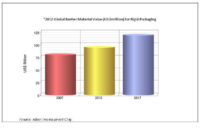High investments in healthcare industry stimulating growth for global medical device packaging market
According to the latest market study released by Technavio (technavio.com), the global medical device packaging market is expected to grow at a CAGR of over 6% from 2016 to 2020.
The research report is titled “Global Medical Device Packaging Market 2016-2020” and provides an in-depth analysis of both revenue and emerging market trends. The research report also includes up to date analysis and forecast estimates for various market segments and geographical regions.
The report states medical device manufacturers, diagnostic centers, and hospitals are the major end-users in this market. Products such as containers, pouches, multiple compartment trays, clamshell packs, blister packs, and glass vials are used to package large medical devices, contact lenses, diagnostic reagents, and syringes. Medical device packaging is governed by strict regulations as the devices are typically sterilized.
“As a result of reforms and high investments in the healthcare industry, newer and more efficient medical devices and drugs are being introduced in the market. Healthcare companies such as Johnson & Johnson, Medtronic, and Siemens continuously undertake efforts to develop advanced, innovative, and efficient medical devices and drugs for diagnosis and treatment,” says Technavio lead packaging research analyst Sharan Raj. “The growth of the market is attributed to the need for packaging companies to supply convenient packaging solutions to customers across all healthcare facilities,” Sharan added.
The global medical device packaging market is largest in Europe which accounts for over 32% of the market. The European market is expected to reach nearly USD 8 billion by 2020, growing at a CAGR of 5.6%. Europe will benefit from the introduction of new product devices and the upgrading of regulatory and industry standards for the sterility, barrier, utility, and tracking features of medical device packaging. The ISO 11607 is the main guideline followed worldwide for medical packaging material.
The global medical device packaging market in APAC is the fastest growing region. This region is expected to be worth USD 6.7 billion by 2020, growing at a CAGR of 7%.
"Japan is among the most prominent developed countries for medical devices, while developing countries such as China and India are also experiencing a high adoption of medical devices,” says Raj. "OEMs are looking at these countries because of the investment-friendly environment and low taxation.”
The global medical packaging devices market is segmented into four product types:
- Clamshell Packs
- Trays
- Pouches
- Other
Clamshell Packs
Clamshell Packs is the fastest growing segment in market with an expected CAGR of 6.6% through 2020. Clamshell packaging has various advantages in terms of appearance, convenience in portability, and is especially easy to open. Clamshell packaging is extensively used to pack various items such as surgical and medical instruments and surgical appliances. This segment is expected to reach close to USD 3.2 billion by 2020.
Trays
The trays segment is the second fastest growing in the market and the largest in terms of revenue. The trays segment is expected to reach USD 8.2 billion in 2020. Thermoformed trays offer the following benefits:
They save storage space as thermoformed plastic trays can be stacked on top of each other.
The ability of trays to be stacked one above reduces restocking labor during its distribution process.
Thermoformed trays are usually made of plastic and can be reused. This provides companies with cost advantages. They are also lightweight and easy to handle.
Pouches
Moderate growth is expected for the pouches segment, growing at a CAGR of just under 6%. The segment is expected to reach USD 7.24 billion by 2020, an increase of almost USD 2 billion from its 2015 value.
Pouches are made from two or more dissimilar materials, including aluminum film, paper, or tyvek. Cardiovascular implants are usually packed in pouches made from a combination of polyethylene and tyvek, or nylon (on the inside) and tyvek. As tyvek is porous, it permits the gases used for sterilization to penetrate the packaging. The ability to endure sterilization is a basic requirement for packaging materials of medical products.
Looking for a reprint of this article?
From high-res PDFs to custom plaques, order your copy today!





